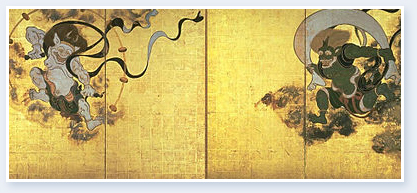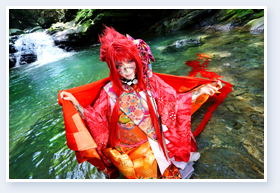Anthropomorphism is the attribution of human-like appearances or qualities to plants, inanimate objects, things, nature, concepts or anything other than a human being.
Anthropomorphism has existed in Japan since ancient times, as illustrated in the history of nature worship and idolization based on the tenet of the multiple god belief system that "there is a soul residing in all things in the universe."
Flash forward to the 21st century. Even in this age of rapidly progressing scientific technology and information networks, anthropomorphism remains a part of the Japanese psyche, though the form and expressions have changed. (most especially in terms of relationships toward fictional characters (moe).)

Tawaraya Sotatsu "Wind God and Thunder God" (17th century) |

Shibuki "Goldfish" (21th century) |
For example, as children we were all familiar with fairy tales and picture books. We accepted without question or doubt these worlds where animals, plants and even inanimate objects are look and act like humans.
Also, in Japan, the humanization of characters within the so-called "moe culture" is gaining attention.
This project focuses on a form of anthropomorphism known as gijinka found within the world of cosplay. Although few opportunities for taking center stage existed in the past, the "actual creation of characters" within manga, anime, games and other two dimensional art forms has been steadily gaining popularity and support as a highly respected, more creative genre within the booming world of cosplay.
This project aims to spotlight those expressionists who pour their heart and soul into "Modern Gijinka" within the world of cosplay.
We hope that this project will contribute to the further development of the Gijinka cosplay genre.
Also, we hope to feel your passion for Gijinka cosplay through the character design entries we receive.
|












